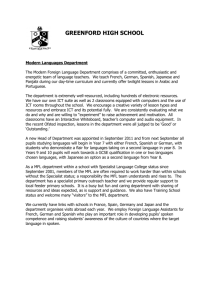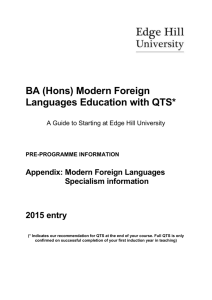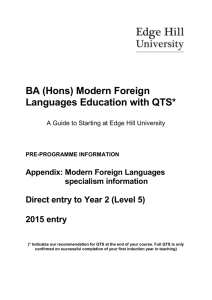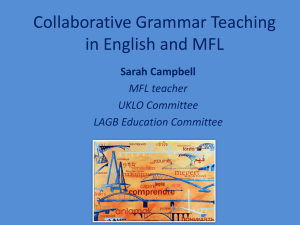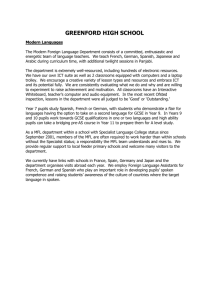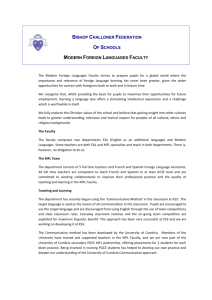Boys` Performance in Modern Foreign Languages: Listening to
advertisement
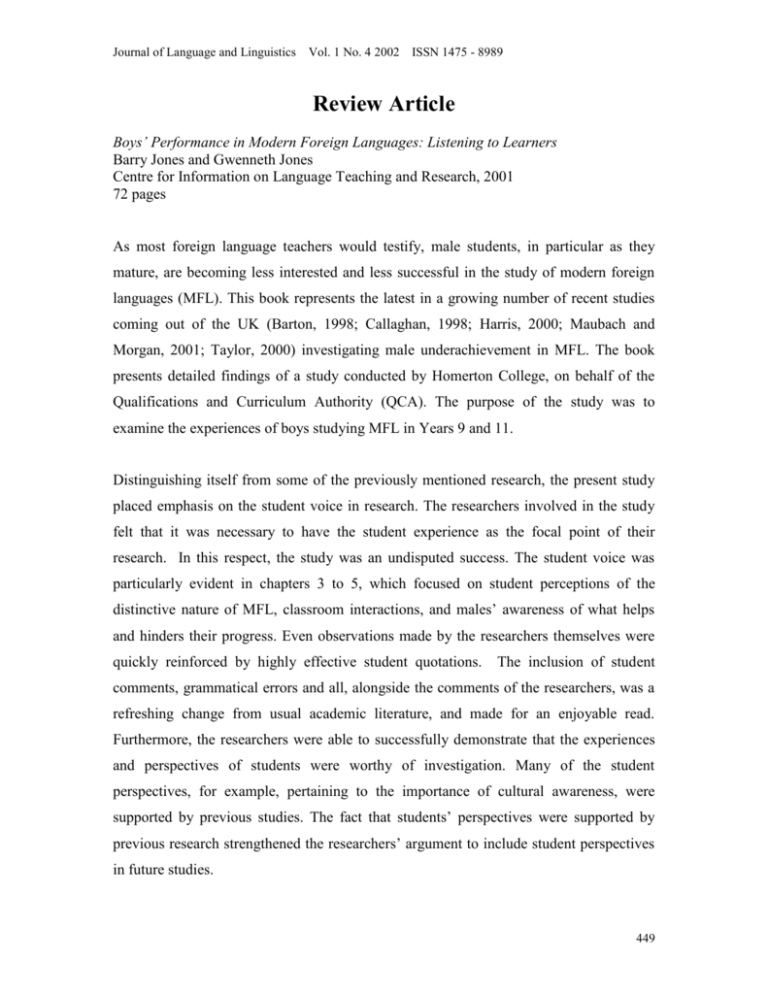
Journal of Language and Linguistics Vol. 1 No. 4 2002 ISSN 1475 - 8989 Review Article Boys’ Performance in Modern Foreign Languages: Listening to Learners Barry Jones and Gwenneth Jones Centre for Information on Language Teaching and Research, 2001 72 pages As most foreign language teachers would testify, male students, in particular as they mature, are becoming less interested and less successful in the study of modern foreign languages (MFL). This book represents the latest in a growing number of recent studies coming out of the UK (Barton, 1998; Callaghan, 1998; Harris, 2000; Maubach and Morgan, 2001; Taylor, 2000) investigating male underachievement in MFL. The book presents detailed findings of a study conducted by Homerton College, on behalf of the Qualifications and Curriculum Authority (QCA). The purpose of the study was to examine the experiences of boys studying MFL in Years 9 and 11. Distinguishing itself from some of the previously mentioned research, the present study placed emphasis on the student voice in research. The researchers involved in the study felt that it was necessary to have the student experience as the focal point of their research. In this respect, the study was an undisputed success. The student voice was particularly evident in chapters 3 to 5, which focused on student perceptions of the distinctive nature of MFL, classroom interactions, and males’ awareness of what helps and hinders their progress. Even observations made by the researchers themselves were quickly reinforced by highly effective student quotations. The inclusion of student comments, grammatical errors and all, alongside the comments of the researchers, was a refreshing change from usual academic literature, and made for an enjoyable read. Furthermore, the researchers were able to successfully demonstrate that the experiences and perspectives of students were worthy of investigation. Many of the student perspectives, for example, pertaining to the importance of cultural awareness, were supported by previous studies. The fact that students’ perspectives were supported by previous research strengthened the researchers’ argument to include student perspectives in future studies. 449 Journal of Language and Linguistics Vol. 1 No. 4 2002 ISSN 1475 - 8989 From the experiences and perceptions of the students and teachers involved in the study, a number of recommendations were made in chapter 7. Although not specifically stated as a goal of the study, it was nevertheless implied that these recommendations and suggestions were intended to assist both foreign language educators and curriculum designers better reach male students. While the recommendations appeared to be quite sound, by this point in the book it was apparent that no two students were alike, and what might work for one student may not for another. Some students were reported to prefer easier foreign language tasks, while others were reported to prefer more challenging work. Some students liked teacher-directed lessons, and others preferred more autonomy. From such variety of responses an important lesson could be learned. As eclectic as are the reasons behind male underachievement in MFL, so must be the approaches to deal with them. Teachers need to use a variety of techniques in order to reach the largest number of students possible. In this respect, the book was useful. A number of suggestions and recommendations were provided to help teachers improve male performance in MFL. The study was well organized into 8 concise chapters. A great deal of information was condensed into approximately 70 pages of straightforward text in which technical jargon was kept to a minimum; undoubtedly an additional benefit of student input. The inclusion of a number of easy to follow charts and graphs made the information provided that much more accessible. As a result, the book is suitable for a wider audience. Teachers, administrators, and curriculum developers alike could benefit from the many insights provided. They may further benefit from the comments made by foreign language teachers in chapter 6, and the subsequent teaching recommendations in chapter 7. Although it would seem logical to seek the advice of those on the frontline, the opinions of teachers are also often neglected when designing curriculum. Students themselves could benefit from reading this book. By reading chapters 3 to 5, frustrated, unmotivated, and underachieving males in MFL may find solace in knowing that they are not alone in their struggles. Lastly, the synthesis of a large number of existing studies on gender 450 Journal of Language and Linguistics Vol. 1 No. 4 2002 ISSN 1475 - 8989 differences in MFL provided in the literature review, would also make the book useful to scholars looking to do additional work in this area. Having stated that the book was well organized, it was, however, initially puzzling as to why the researchers chose to place the literature review at the end of the book in an appendix. Throughout the book the authors had used a format similar to that of an actual study, beginning with the problem of male underachievement in chapter 1, and then moving on to the method’s and results’ sections in chapters 2-7. Following this format, it would have seemed more appropriate to include the literature review near the beginning, before the results’ section. However, as previously stated, the literature review provided validation for many of the student perceptions. In this respect, while reading the literature at the end of the book, the reader was impressed by how precise and accurate many of the student perceptions actually were. Had the researchers followed the typical format, the reader would have already been aware of the existing research and the student perceptions would have, as a result, seemed less remarkable. The placement of the literature review, thus, only served to highlight the importance of student perspectives in research. The literature review, itself, adequately dealt with a number of pertinent issues related to the student perspectives. A number of other key areas, which were touched upon by the students, and where significant gender differences have been reported, such as integrative orientation, self-determination, challenging work, and self-efficacy, were, however, ignored. Had these findings been included in the literature review, they would have served to further validate the students’ perspectives. In addition, it appears that the focus of the literature review was narrowed to include only studies of origin in the UK. This is unfortunate, in light of some important research that has been conducted on gender differences in second language acquisition in Canada and the United States. The inclusion of other, seminal studies, coming from sources outside of the UK may have made the literature review stronger and more applicable to a wider audience. 451 Journal of Language and Linguistics Vol. 1 No. 4 2002 ISSN 1475 - 8989 Although the methods’ section of the study, presented in chapter 2, was, in general, quite thorough with respect to subject selection, instrumentation and procedure, a few minor limitations were noted. The questions asked during the student interviews, for example, were not provided. The inclusion of a sample of these questions may have helped to alleviate the threat of researcher bias. It was mentioned that one of the participating schools that bucked the trend and had male foreign language students performing above the national average, tended to draw the more able students. The ability level of these students may have been the reason why the students were in fact bucking the trend. Furthermore, two different field workers were used in the data collection procedure, with one tending to work with the stronger group. This, of course, raises the possibility of data collector bias. Despite these minor concerns, the strengths of this book outweigh its weaknesses. While investigating boys’ experiences in MFL, the researchers were able to not only provide valuable insights and recommendations to address the problem of male underachievement, but also to emphasize the legitimacy of having students play an active role in academic research. The authors accomplished these goals in an innovative and refreshing manner, making this book a valuable resource for all those interested in learning and teaching MFL. Reviewer: Scott Kissau, University of Windsor, Canada Email: scotkiss@attcanada.ca References Barton, A. 1998. Unlikely linguists? Raising achievement in modern languages in all-boy teaching groups. The Linguist 37 (3), 80-83. Callaghan, M. 1998. An investigation into the causes of boys’ underachievement in French. Language Learning Journal 17, 2-7. Harris, V. 1998. Making boys make progress. Language Learning Journal 18, 56-62. 452 Journal of Language and Linguistics Vol. 1 No. 4 2002 ISSN 1475 - 8989 Maubach, A., & Morgan, C. 2001. The relationship between gender and learning styles amongst A level modern languages students. Language Learning Journal 23, 4147. Taylor, A. (2000). Boy-free zone? Language Learning Journal 21, 3-7. 453
